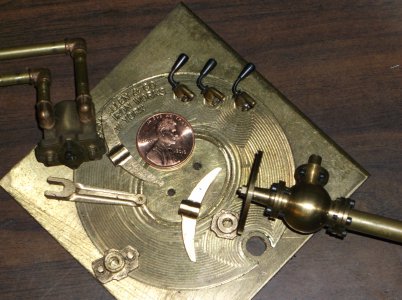I take a stab at Rogerrabbit's outline
Ok, I'll give it a shot where I would like to see this go (on a 5k ft level)
1. Types of implementations:
A. Lathe type CNC
B. Mill type CNC (i would include the home built CNC router type solutions).
A. how do they work? (basics right? )
CNC is Computer Numerical Control. According to wikipedia
Numerical control (NC) refers to the automation of machine tools that are operated by abstractly programmed commands encoded on a storage medium, as opposed to controlled manually via handwheels or levers, or mechanically automated via cams alone.
So, we are using a computer (and software running on that computer) to control a machine tool. That could be any of the items listed above. LinuxCNC will control up to 9 axes. According to their website, Mach3 will do up to 6 axes. Axes are points where the machine can moved. Think X, Y, and Z axes on a milling machine. Given that, all types of computer controlled machines operate the same more or less.
B. what are the differences?
Number of axes, work envelope, material, type of operations capable.
For example, a CNC lathe, just like a manual lathe, is going to produce cylindrical work, and a mill is going to produce prismatic work. We can blur the line here, but in general you are going to use a CNC lathe for the same thing you would use a manual lathe for, its just that a computer is turning the knobs based on instructions you gave it, rather than you actually turning the knobs by hand.
Some other examples
- CNC Router/gantry router. These are basically milling machines. They tend to have really large work areas in the X and Y, and relatively small Z work envelopes. Usually they have small, high speed spindles (routers are common), and are used on wood or plastic, but sometimes aluminum. If you are into woodworking, want to make signs, or quick prototypes out of plywood, or mdf, this is probably the machine for you.
- Hot wire cutter. Are you into model planes? I'm not actually sure what else you would use a hot wire cutter for... anybody else?
- Plasma cutter. Are you a welder? Want to make custom metal work? This may be for you. They tend to have similar stats to a gantry router, except that instead of a high speed spindle, they use a plasma cutting nozzle. LASER cutters would be more or less the same, except using a laser instead of a plasma nozzle. Waterjets too.
C. If I am new to the CNC world, which type should a start with assuming I have either both a mill and lathe or neither.
I would say, figure out what you want to make, and then get the machine that will let you do that. Mills are probably the most common and versatile, but if you want to make large things, a router would probably suit you better. If you want to cut lots of sheet steel, you are going to be disappointed with a milling machine, and probably would be happier with a plasma cutter.
If you just want to explore the technology, and see what is possible, I would say a small CNC, desktop CNC router would be the cheapest route to this. 3D printers would be a close second. Both can be had for a couple hundred dollars US, and will fit on your dining room table, stow-able under the bed or in a closet when not in use.
D. for each, buy a machine, convert existing, or build from scratch?
Something like
new: high $$$, but software & machine integrate well.
convert: med $$, but kit may not be available, anyone have experience with a kit they would like to share/
build: low $, but you need to plan ahead to make sure software works with machine.
Honestly, software comparability with home built machines is not a concern. LinuxCNC and Mach3 (though I have no direct experience with Mach) are really configurable, and can do a great deal. The main things you have to consider are
1) How much work
2) How much money
3) Who do I call if there is a problem?
Everything is gonna depend on what type and size of machine you chose. I picked up a used knee mill and am converting it myself. I am probably into the project to about $3k, and I don't even have ballscrews yet. To put that in perspective though, if I had purchased a new Tormach, I would have been up to $8k already, probably more with accessories. That being said, I would have a ready made, solid machine, with lots of accessories made for it, and somebody I could call when things go wrong

.
Now, if I had purchased a new knee mill, the price difference at the end of the day would have been basically zero. If you are going with a small machine like an X2, then you would have to do the math.
The main thing to consider is that you want to stick with the basic formula. Lathes have 2 axes. Mills have 3 (or more, lets ignore that for now). The trick here is that there is a lot of software out there (CAM software) that takes CAD drawings and produces GCode to control your machine. If you have some oddly configured machine, off the shelf software is not gonna work. So stick with the basic formula.
The other possibility is that you write the GCode yourself (it's very doable), but for complicated things, it can get... tedious.

